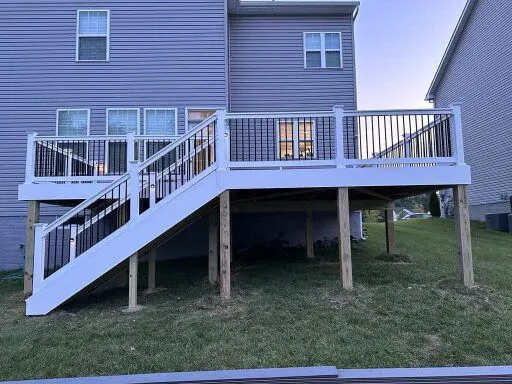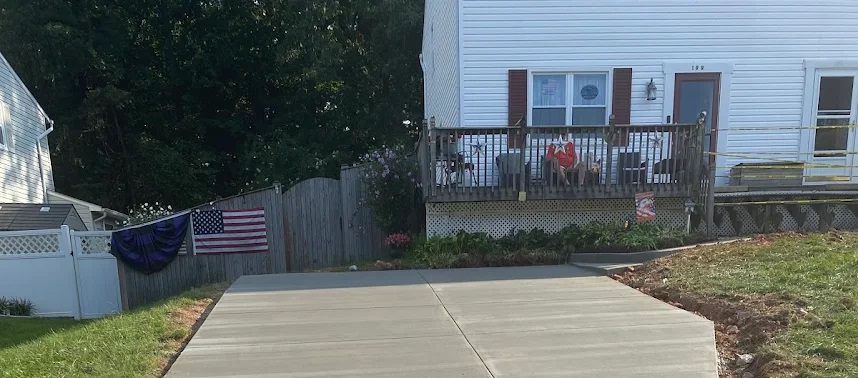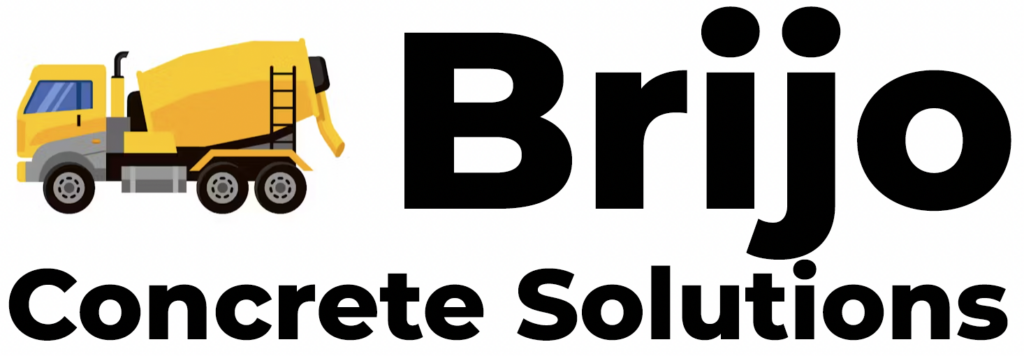Choosing the Right Deck Material: Wood, Composite, or PVC?
Let Us Help With Your Choice
A deck is more than just an outdoor structure—it’s an extension of your home, a place for relaxation, entertainment, and making memories with family and friends. Choosing the right material for your deck is one of the most important decisions in the installation process. The material you select will impact the deck’s durability, maintenance requirements, and overall aesthetic appeal for years to come.
With so many custom decking materials available, how do you choose the best one for your home? The three most popular options are wood, composite, and PVC decking—each with its own advantages, drawbacks, and price points. This guide will help you weigh the pros and cons of each material so you can make the best decision for your needs, budget, and lifestyle.
Wood Decking: Classic Beauty with Natural Appeal
Wood has been the traditional choice for decks for decades due to its natural beauty, versatility, and affordability. It provides a classic, warm aesthetic that blends seamlessly with outdoor environments.
Types of Wood for Decking
Not all wood is the same when it comes to custom decking. The most commonly used types include:
Pressure-Treated Lumber (PT Wood)
- One of the most affordable wood decking options.
- Treated with chemicals to resist rot, insects, and decay.
- Requires regular maintenance (sealing and staining) to prevent warping and splintering.
Cedar and Redwood
- Naturally resistant to insects and decay.
- More durable than pressure-treated wood but still requires maintenance.
- Offers a rich, natural color that can be preserved with regular sealing.
Hardwoods (Ipe, Mahogany, Tigerwood)
- Dense, durable, and resistant to weather, insects, and rot.
- High-end option with exceptional longevity.
- More expensive and challenging to install due to its hardness.
Pros of Wood Decking
✅ Aesthetic Appeal – Provides a warm, classic, and natural look.
✅ Customizable – Can be stained or painted in different colors.
✅ Affordability – Pressure-treated wood is one of the most cost-effective options.
✅ Biodegradable – An environmentally friendly material option.
Cons of Wood Decking
❌ High Maintenance – Requires regular staining, sealing, and cleaning.
❌ Prone to Weather Damage – Can warp, crack, or rot over time.
❌ Shorter Lifespan – Compared to composite and PVC, wood decks have a shorter lifespan.
Best For: Homeowners who love the natural beauty of real wood and don’t mind regular upkeep.
Composite Decking: The Low-Maintenance Alternative
Composite custom decking is made from a blend of wood fibers and plastic, designed to mimic the look of wood without the high maintenance. It has become an increasingly popular choice due to its durability and longevity.
How Composite Decking is Made
Composite decking consists of:
Recycled wood fibers and plastic (usually polyethylene or polypropylene).
Capped vs. Uncapped Composite: Capped composite has a protective outer shell that enhances durability and stain resistance.
Pros of Composite Decking





Cons of Composite Decking



Best For: Homeowners who want the look of wood but prefer a deck with minimal maintenance.
PVC Decking: The Ultimate in Durability
PVC (polyvinyl chloride) decking is a synthetic material that contains no wood fibers. It’s 100% plastic, making it incredibly durable and resistant to moisture, insects, and rot.
How PVC Decking is Made
PVC custom decking is composed of:
Plastic polymers that provide superior water resistance.
Capped Technology to enhance stain and scratch resistance.
Pros of PVC Decking
✅ Ultra-Low Maintenance – No need to stain, seal, or paint.
✅ Waterproof – Excellent for areas with high humidity or near pools and waterfront properties.
✅ Mold and Mildew Resistant – Ideal for damp or shaded locations.
✅ Lightweight – Easier to install than composite decking.
✅ Long Lifespan – Can last 30+ years with proper care.
Cons of PVC Decking
❌ Expensive – One of the most costly decking materials.
❌ Can Look Plastic-like – Some homeowners feel it lacks the natural appeal of wood.
❌ Expansion and Contraction – Can be more susceptible to temperature changes, which may cause boards to expand or contract over time.
Best For: Homeowners looking for a premium, ultra-durable, and waterproof decking solution with virtually no maintenance.
Factors to Consider When Choosing a Decking Material
When deciding on the best decking material for your home, consider the following:
Climate & Weather Conditions
If you live in a wet or humid area, PVC custom decking is the most water-resistant. For areas with extreme heat, lighter-colored composite or wood can help prevent excessive heat retention.
Maintenance Preferences
If you don’t mind regular maintenance, wood is a great choice. If you want a low-maintenance deck, composite or PVC is the way to go.
Budget
Wood is the most budget-friendly option upfront. Composite and PVC decks require a higher initial investment but save money in maintenance costs.
Aesthetic Preference
Wood provides a natural look with rich grain patterns. Composite and PVC offer a consistent appearance with modern color options.
As homeowners become more eco-conscious, sustainability is an important factor in choosing custom decking materials. While all three options—wood, composite, and PVC—have different environmental impacts, understanding their sustainability can help you make a responsible choice.
Wood: Renewable but High-Maintenance
- Pros: Wood is a natural, renewable resource and biodegradable. When sourced responsibly from sustainably managed forests, it can be an environmentally friendly choice.
- Cons: The frequent staining, sealing, and treatment required for wood decks often involve chemicals that can be harmful to the environment. Deforestation is also a concern, particularly with exotic hardwoods.
Composite: Recycled and Long-Lasting
- Pros: Many composite decking brands use recycled materials, including reclaimed wood fibers and plastic. This reduces landfill waste and decreases the demand for virgin materials.
- Cons: While composite decks last longer and require less maintenance, they aren’t biodegradable. Once they reach the end of their lifespan, disposal can be challenging.
PVC: Highly Durable but Non-Biodegradable
- Pros: PVC decking is often made from recycled plastics, making it an eco-conscious choice. Because it lasts longer than wood and composite, it reduces the need for replacement materials.
- Cons: PVC is entirely synthetic and non-biodegradable, meaning it doesn’t break down naturally. However, some brands offer recycling programs to repurpose old PVC decking.
The Verdict: If sustainability is a top priority, composite decking made from recycled materials is often the best compromise between longevity and environmental responsibility. If you choose wood, look for FSC-certified (Forest Stewardship Council) lumber to ensure responsible sourcing.
Deck Customization: Enhancing Your Outdoor Living Space
Once you’ve chosen your custom decking material, consider how to customize your deck to match your lifestyle and aesthetic preferences.
Railings and Balusters
- Wood railings offer a classic, rustic look that complements wood decks.
- Metal or glass railings provide a modern touch and work well with composite and PVC decks.
Lighting for Ambiance and Safety
- Solar-powered deck lights enhance eco-friendliness while adding nighttime visibility.
- Recessed LED lighting installed along stairs and railings improves safety and aesthetics.
Built-In Seating and Storage
- Wooden benches with hidden storage compartments maximize space.
- Custom seating areas make decks more inviting and functional.
Shade and Shelter
- Pergolas and awnings provide protection from the sun and extend deck usability.
- Retractable canopies offer flexibility for different weather conditions.
A well-designed deck isn’t just about the material—it’s about creating a personalized outdoor retreat. No matter which material you choose, thoughtful additions can transform your deck into a beautiful, functional space for relaxing and entertaining.
Cost Comparison: Weighing Upfront Investment vs. Long-Term Value
When choosing a custom decking material, cost is a major consideration—not just the initial investment but also the long-term expenses related to maintenance and durability. While some materials have a lower upfront cost, they may require frequent upkeep, while others with a higher initial investment offer long-term savings through minimal maintenance.
Pressure-Treated Wood: Budget-Friendly but Requires Regular Upkeep
- Typically the most affordable option when installing a deck.
- Requires ongoing maintenance, such as staining and sealing, to prevent weather damage and deterioration.
- Over time, maintenance costs can add up, making it a more expensive option in the long run.
- Lifespan is moderate, but without proper care, it can deteriorate faster.
Cedar and Redwood: Naturally Resistant but Higher Maintenance Costs
- More expensive than pressure-treated wood but offers natural resistance to insects and rot.
- Requires regular sealing and staining to maintain its color and prevent weathering.
- Maintenance over time can be costly, but with proper care, it can last longer than pressure-treated wood.
Hardwood (Ipe, Mahogany, Tigerwood): Premium Durability with a Higher Price Tag
- One of the most durable and long-lasting wood options, offering resistance to wear and weather.
- Requires occasional oil treatment to maintain its natural beauty, though it needs less frequent maintenance than softer woods.
- More challenging to install due to its density, which may increase labor costs.
- Long lifespan, making it a worthwhile investment for those who want a deck that lasts decades.
Composite: Higher Initial Cost, Minimal Maintenance
- Costs more upfront than most wood options but requires little to no ongoing maintenance.
- No need for staining or sealing, reducing long-term maintenance expenses.
- Resists common decking issues like rot, warping, and insect damage, making it a cost-effective choice over time.
- Long lifespan, offering excellent long-term value for homeowners who want a hassle-free deck.
PVC: The Most Expensive but the Most Durable
- One of the highest upfront costs among decking materials, but with unmatched durability and low maintenance.
- Does not require staining, sealing, or extensive cleaning, making it one of the most cost-effective options in the long run.
- Resistant to water, mold, and mildew, making it ideal for areas with high humidity or frequent rainfall.
- Longest lifespan of all decking materials, ensuring that homeowners won’t need a replacement for decades.
Which Decking Material is Right for You?
Each decking material offers unique benefits, and the best choice depends on your priorities, budget, and desired level of maintenance.
- Choose Wood if you love the natural look, are comfortable with regular maintenance, and want a budget-friendly option.
- Choose Composite if you want a wood-like appearance with less upkeep and long-lasting durability.
- Choose PVC if you need the most durable, waterproof, and maintenance-free decking material available.
No matter which material you choose, investing in a well-built deck will enhance your home’s value and provide years of enjoyment. If you’re ready to start your deck project, contact Brijo Concrete Solutions today for expert advice and professional installation!




